Stay Longer, Stay Remoter: Southern Tanzania Safari
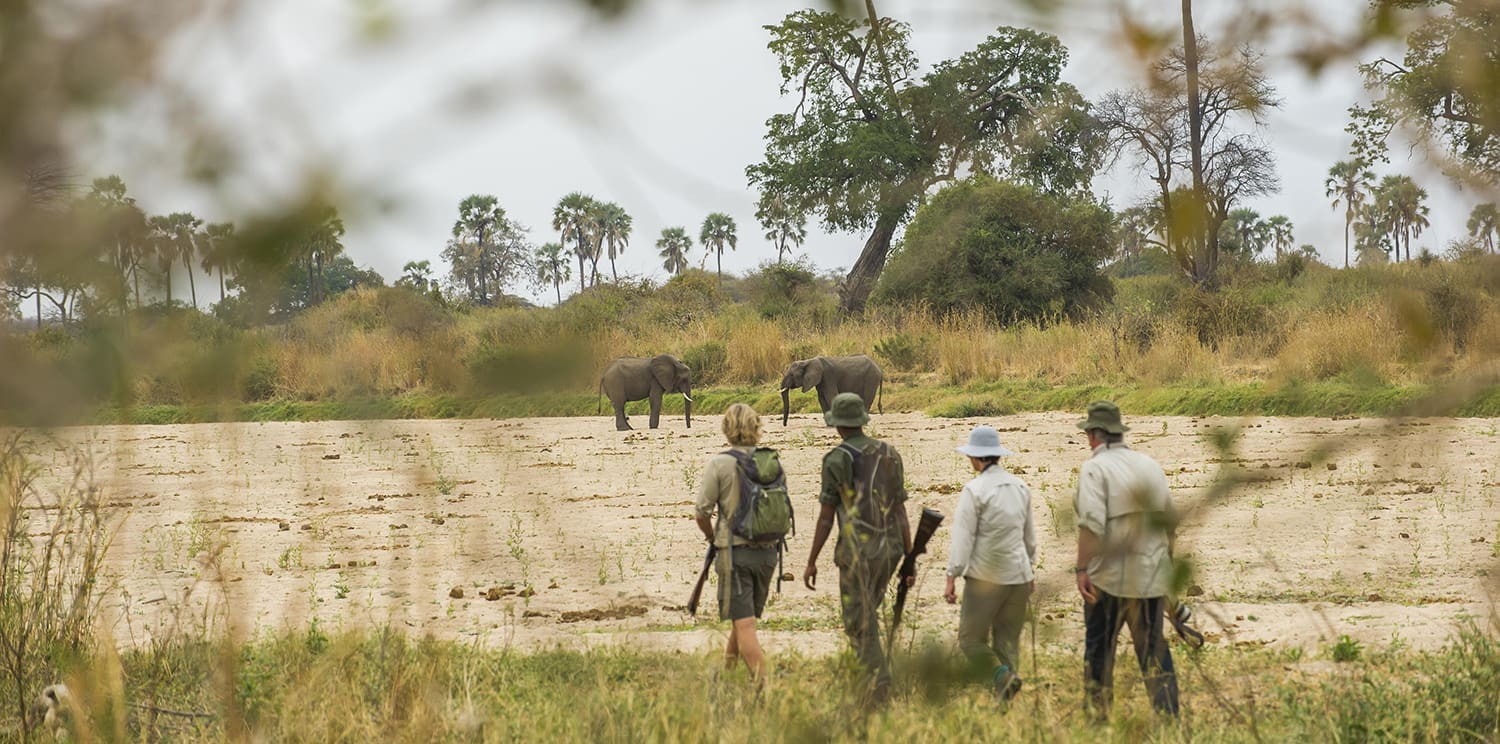
One of the hallmarks of the safari experience is “remoteness.” In many of Africa’s wildernesses, it can seem like safari-goers have it all to themselves. The areas that offer this kind of exclusivity not only enhance the thrills and wonders of the safari experience, but can also allay concerns from those about their health.
A low density of people combined with longer stays can help minimize any health risks. By staying at fewer lodges and camps for longer duration, safariers can minimize in-transit health risks.
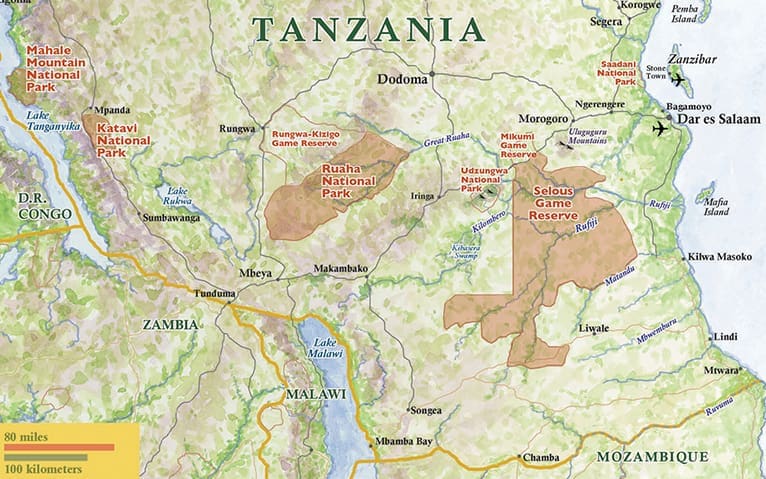
Map of Southern Tanzania
A Southern Tanzania safari fits these criteria. This region’s national parks receive far less tourists than its northern counterparts. Nevertheless, that’s not to say the safari experience is decidedly lesser in the south!
Southern Tanzania provides a more exclusive, off-the-beaten-path safari experience. It also offers activities and wildlife sightings unavailable in the Northern Circuit, like boating and seeing wild dogs! In contrast to the north, walking safaris are a cornerstone of the safari experience in Southern Tanzania – some camps even offer fly-camping to really immerse yourself in the wilderness on foot!
In this iteration of AAC’s “Stay Longer, Stay Remoter” series, we’ll explore three of Southern Tanzania’s national parks and reserves: Ruaha, Nyerere and Katavi. We’ll break down where you can stay, what you can do, and we’ll even give you a suggested itinerary. Start exploring!
Ruaha National Park
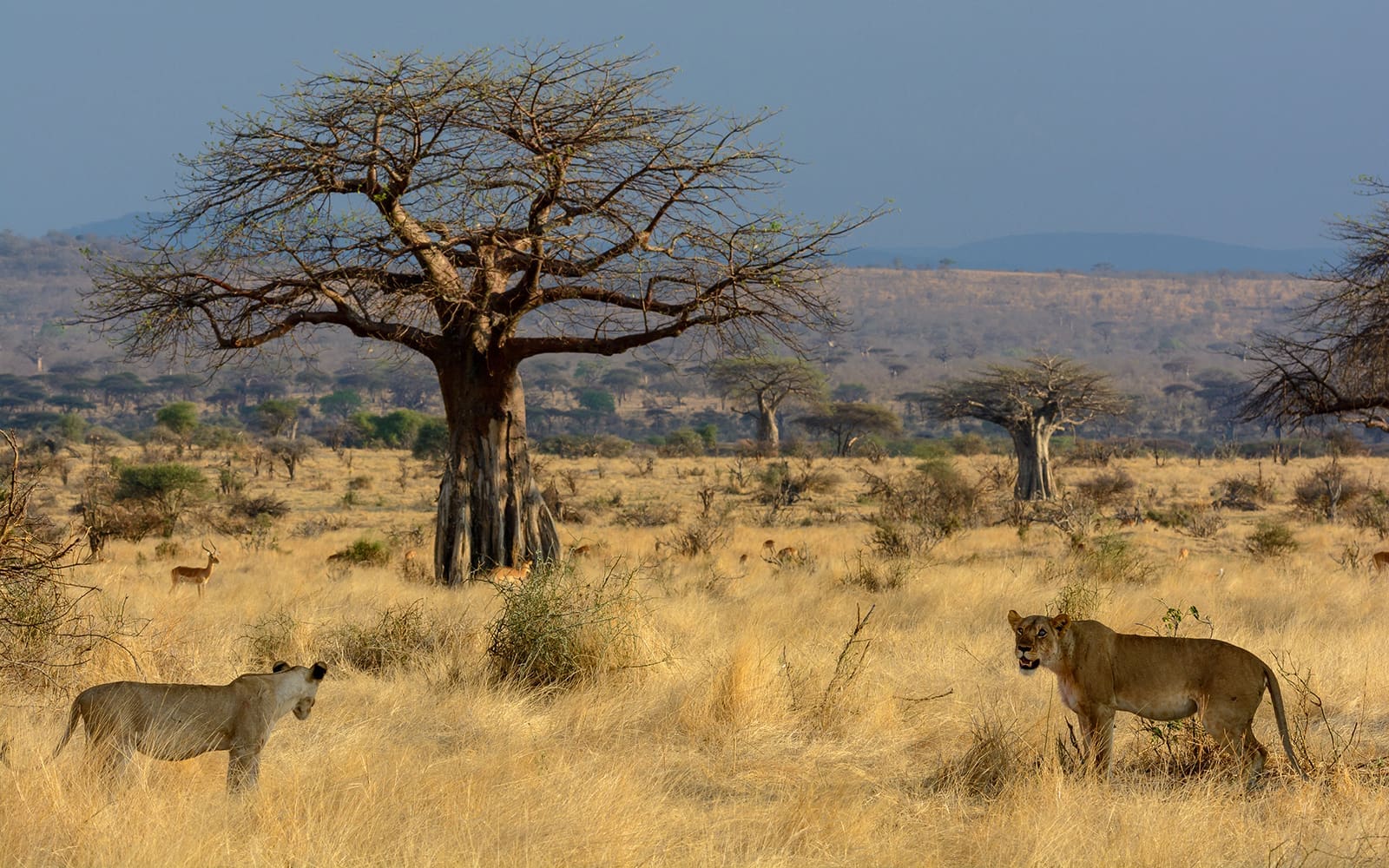
Baobab trees dominate Ruaha’s landscape
Ruaha is Tanzania’s largest national park, and receives only 20,000 annual visitors. In comparison, the Serengeti (Tanzania’s second largest national park) receives 330,000 annual visitors. The park’s landscape can be characterized by a mixture of miombo and acacia woodlands, golden plains, palm trees, the black riverbed rocks of the Ruaha River and other dry riverbeds, the Ruaha escarpment in the west, scattered rocky outcrops and an impressive density of baobab trees.
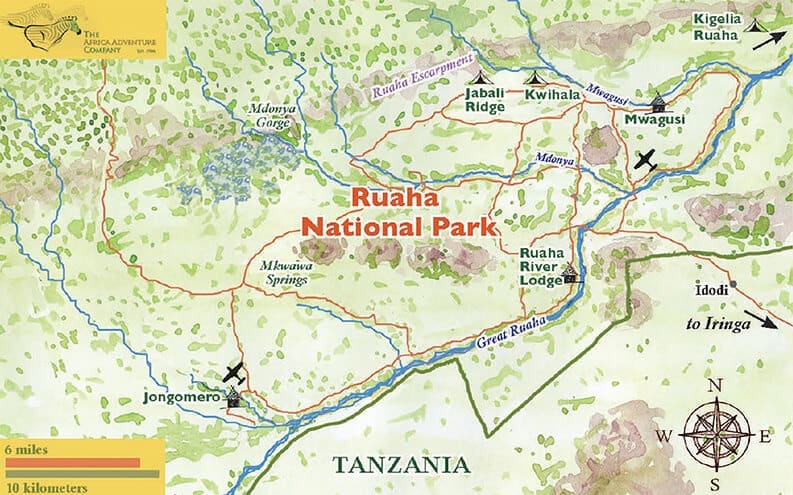
Expect to see felines: this park is a paradise for leopards and lions – 10% of latter’s entire population reside in Ruaha. This park also has the third-largest population of African Wild Dogs (painted wolves). Fortunate visitors can see other predators like cheetah, spotted and striped hyena, and bat-eared foxes.
Besides predators, Ruaha also boasts large buffalo and elephant populations. In addition, the park has an impressive array of antelope species, including kudu (greater and lesser), waterbuck, roan and sable. Giraffes are also a common sight – keep a lookout for them bending down to drink!
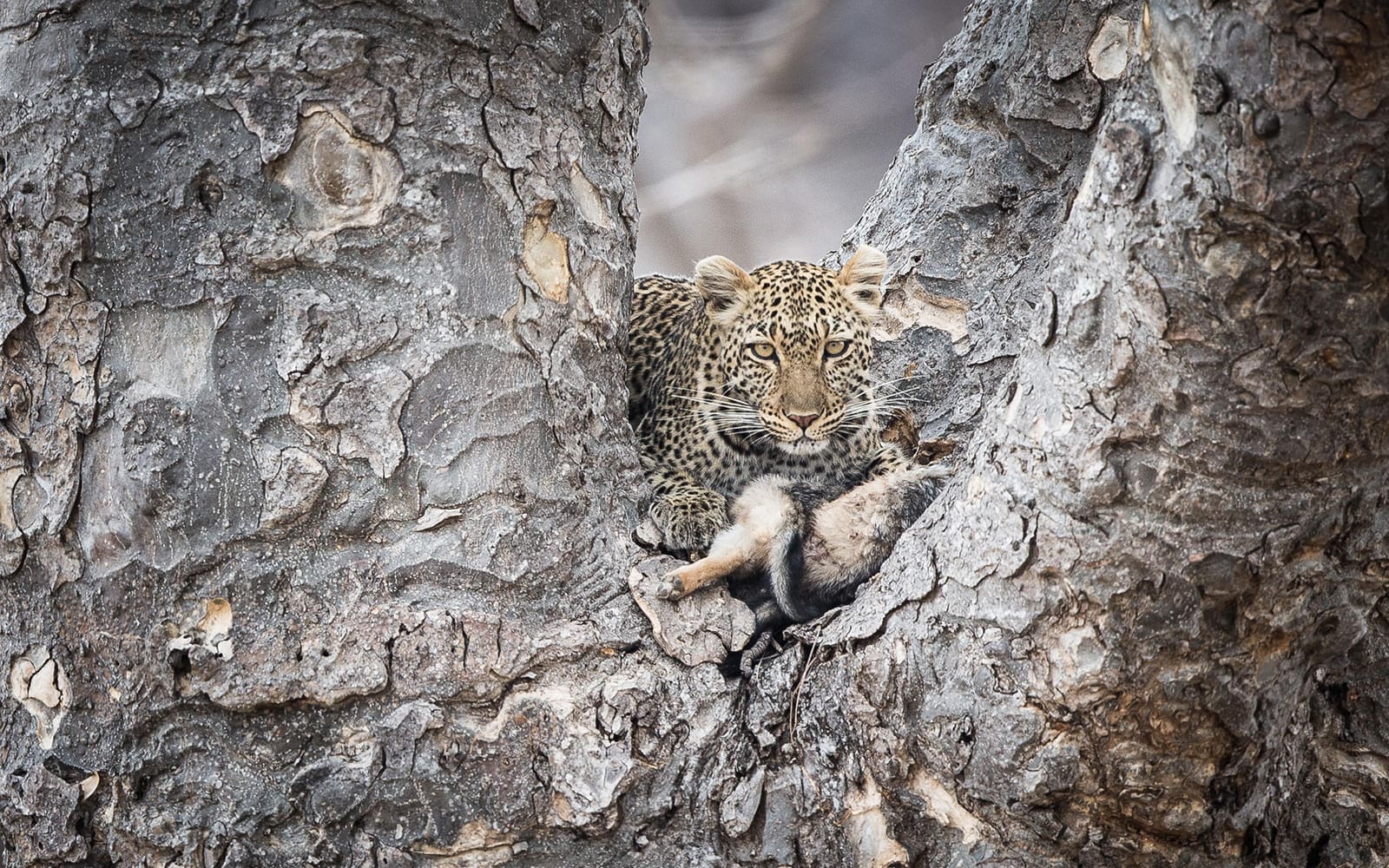
Ruaha has predators in abundance, especially leopards and lions
A very interesting characteristic of Ruaha is that it is a ecological and zoological transition zone between East and Southern Africa. This means there is a fascinating habitat overlap for species. Therefore, it’s no surprise then that over 570 bird species have been recorded here, which makes this park arguably Tanzania’s premier birding destination. Keen birders should visit during the Wet Season (December-April) when both resident and migratory species are present.
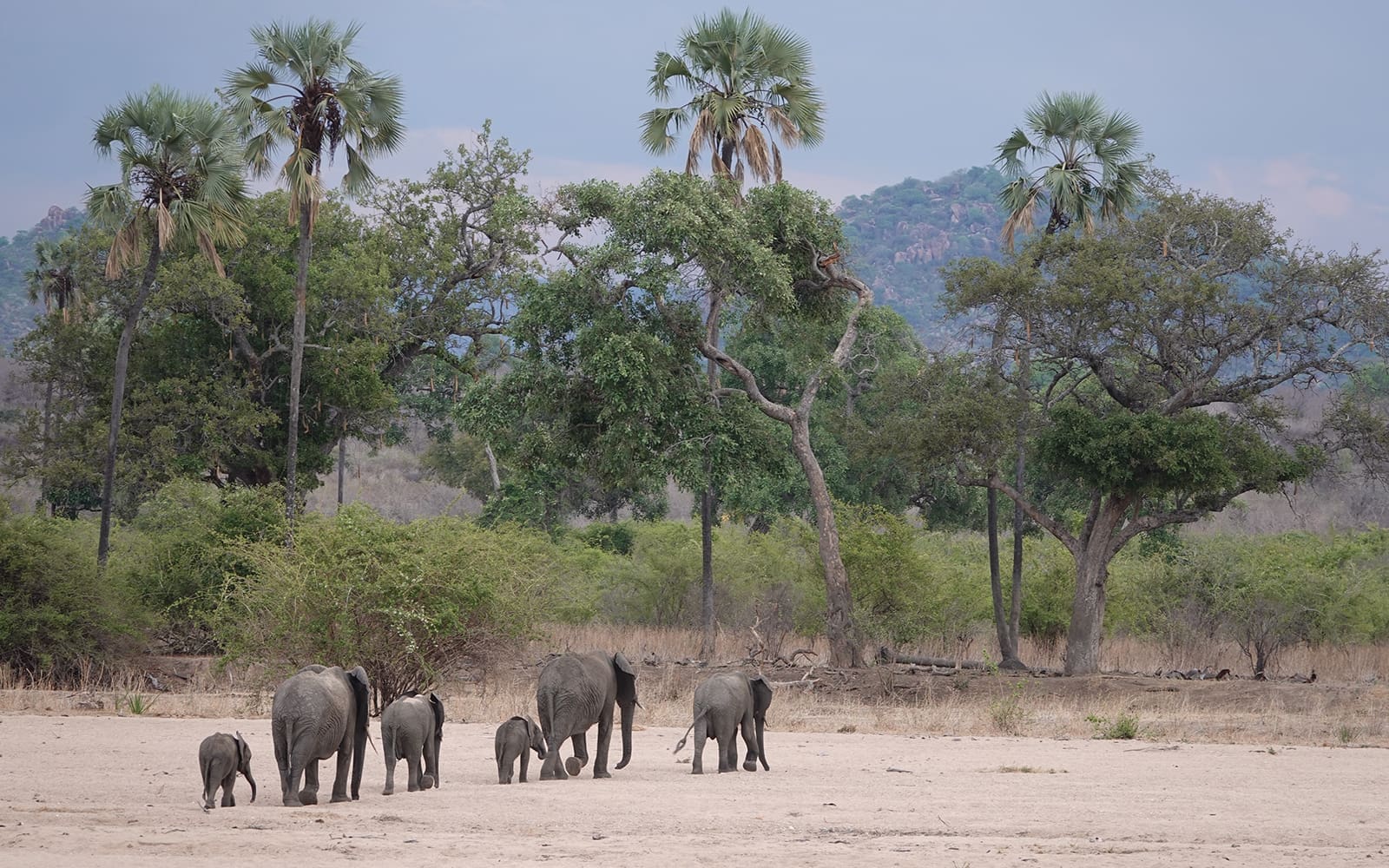
An elephant herd crossing the dry riverbed of the Ruaha River
The Best Time to Go is from July to October. This is when wildlife most heavily concentrates along the Ruaha River, increasing visitors’ chances of great sighting while on a walk or game drive.
June and November are shoulder season. Though a more affordable time of year to visit, it should be noted that each month has its drawbacks. Though the rains of the Wet Season begin to end in May, grasses remain high through most of June, which tends to make animal sightings more difficult.
November is Ruaha’s hottest month. And in any given year, there’s a possibility that the Wet Season’s rains can begin uncharacteristically early, covering the park with thick vegetation. On the other hand, November is a great time to visit because of the “impala drop.” With the arrival of newborn antelopes, you are very likely to see a kill! Miles Nolting visited Ruaha in November and had some spectacular sightings, including this one:
A dramatic scene unfolded while Miles Nolting was on a game drive during his November visit to Ruaha. During a game drive near Jabali Ridge, Miles’ guide spotted a lion dozing off at the foot of a baobab tree. Driving closer, the group also spotted a fresh impala carcass on a branch, and further up the tree, a leopard! After visiting 9 countries over 4 trips in 2019, Miles undoubtedly believes this was his single best wildlife sighting!
Activities in Ruaha
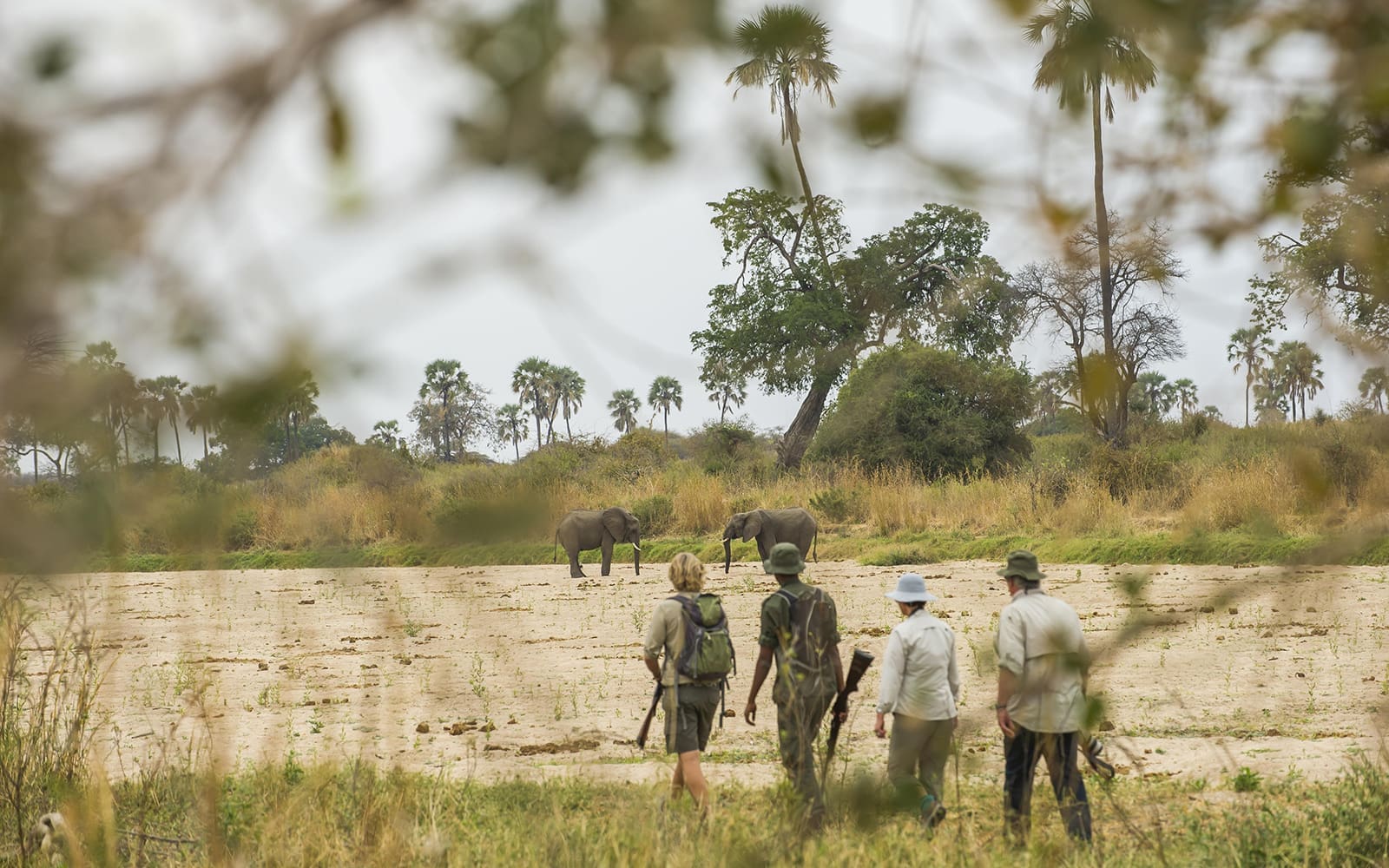
A visit to Ruaha is simply incomplete without a walking safari
As the rivers dry up and the grasses are grazed, a walking safari in Ruaha becomes a must-do. Early morning is the best time of day for a walk – animal activity is high and temperatures are cool enough to make walking comfortable. Walks are escorted by both a licensed walking guide and a park ranger. Furthermore, many walks here are special in that visitors are able to approach many iconic species at jaw-droppingly close distances.
Each camp has different minimum age requirements for walking safaris. Though the terrain can be rugged, it is flat, meaning visitors don’t require a high level of fitness.
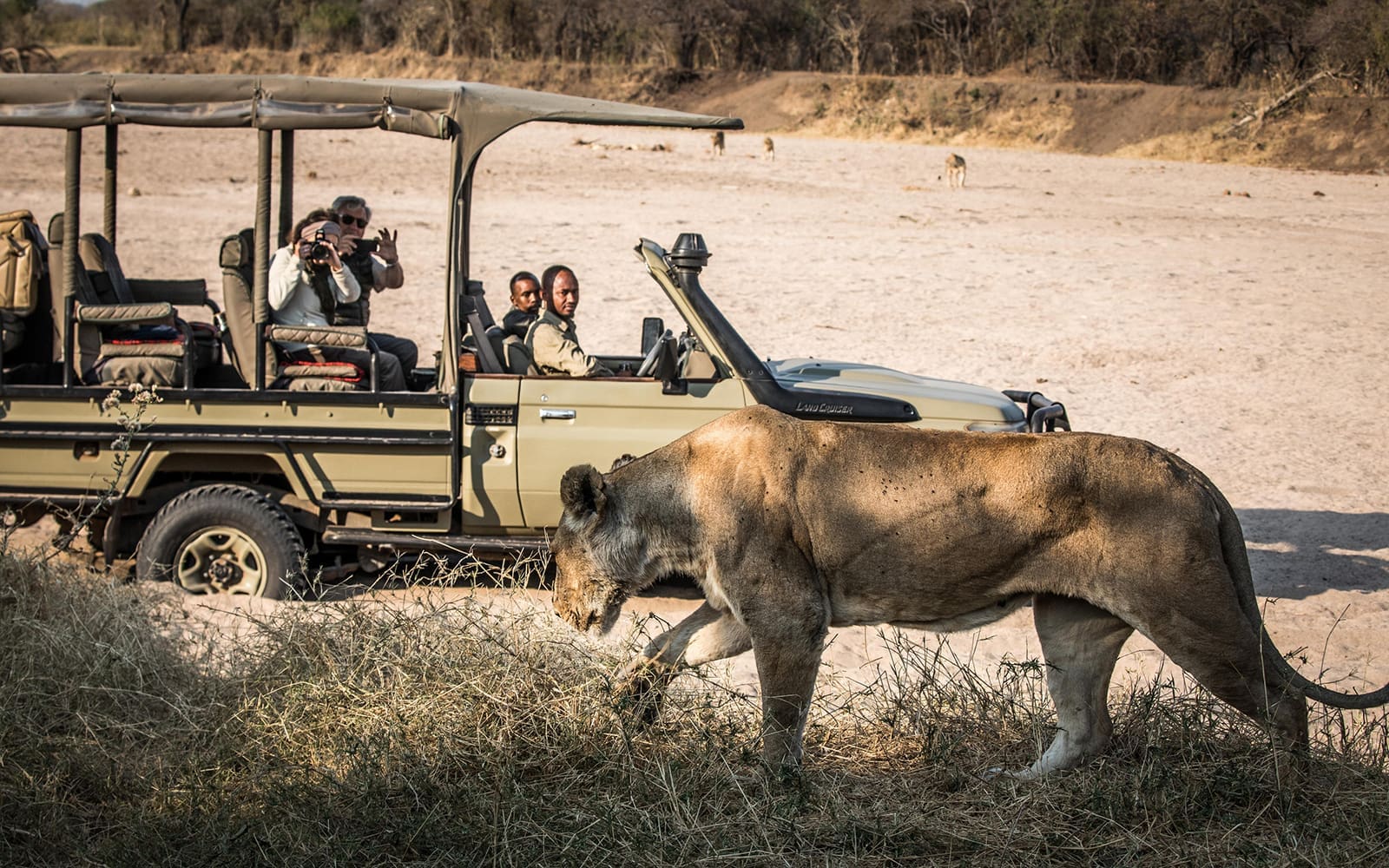
Guides exercise discretion when going off-road to view wildlife
Another great advantage of Ruaha is that night drives are permitted. In Northern Tanzania’s park and wildlife areas, there are very few places where visitors can go on a night drive. Which is a shame – night drives add a fabulous layer to the safari experience, revealing the park’s fascinating nocturnal wildlife. Guides are also given discretion to drive off-road during both night and day game drives. Such a luxury is simply not permissible in the high volume wildlife areas of northern Tanzania.
Where to Stay: Kigelia Ruaha
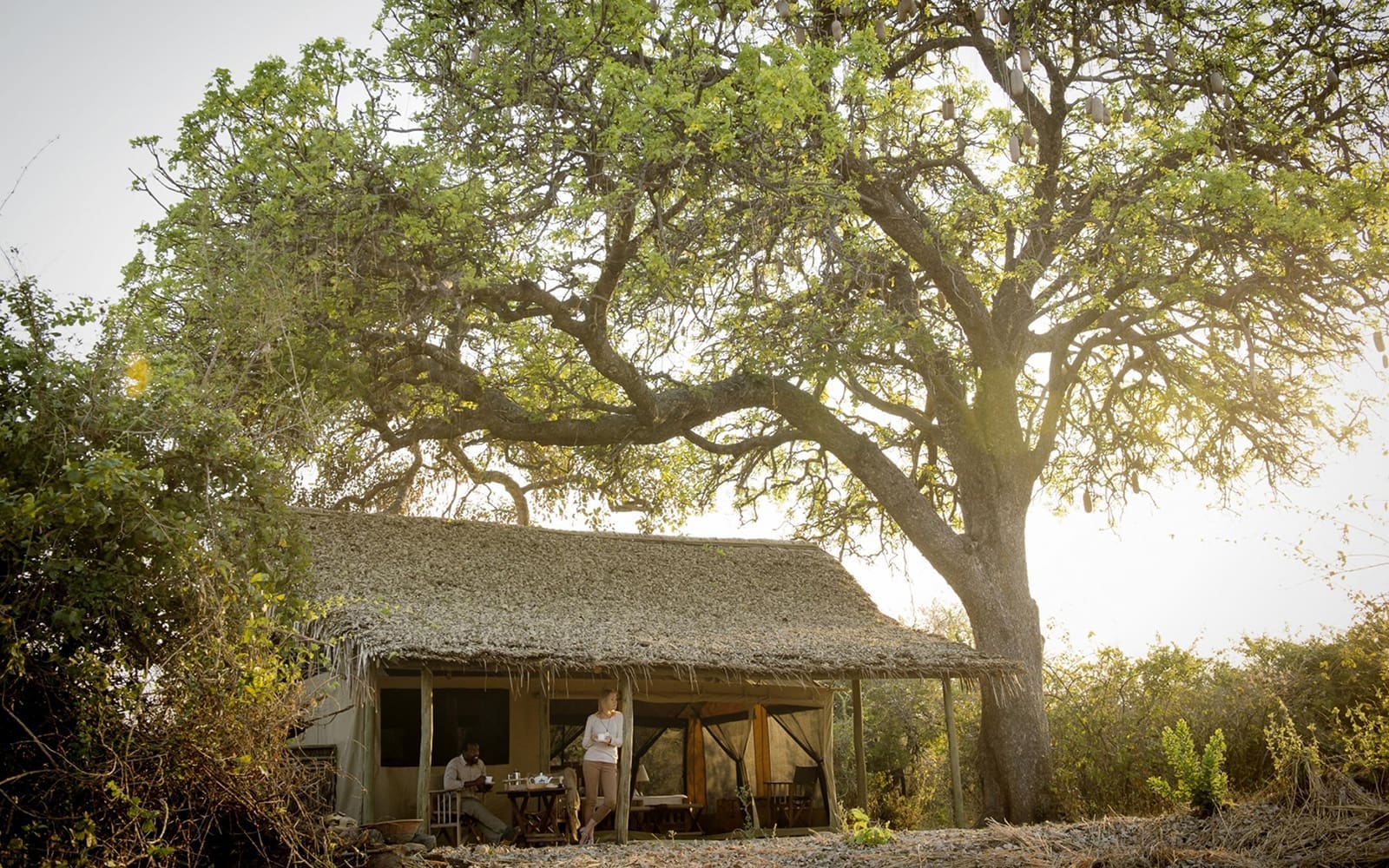
Exterior of a tent at Kigelia Ruaha
For those looking for a “bush experience,” Kigelia Ruaha is a great option. With only 6 banda tents (thatched roof over a canvas tent), this intimate camp offers creature comforts in an authentic bush setting. Each tent has en-suite flush toilets and a safari (bucket) shower. Families or small groups may also reserve the camp’s one family tent.
Where to Stay: Jabali Ridge
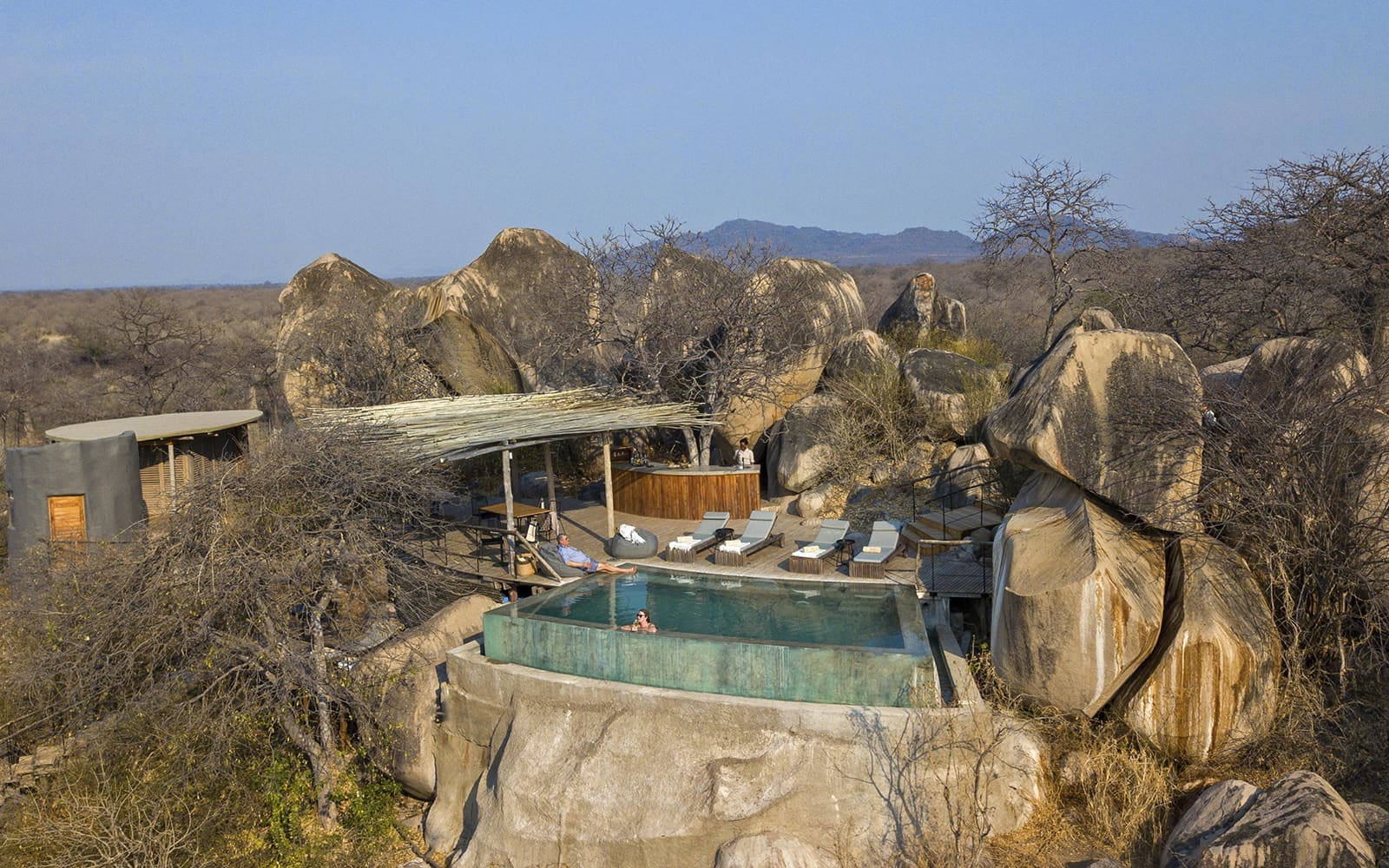
Part of Jabali Ridge is set among massive granite boulders
Simply put, this is Ruaha’s premier accommodation. Jabali Ridge is nestled among giant granite boulders. It offers great amenities, including an infinity pool, spa and expansive library. The dining is also exceptionally tasty and creative – keep an eye out for the baobab sorbet! The lodge features 8 raised, airy suites with bird-nest thatched roofs, wooden shutters (great to let in the breeze during a siesta), en-suite bathroom and an expansive deck. Their is also a private villa (Jabali Private House) nearby, but separate from the main lodge. It features 3 bedrooms, its own pool, and a private guide, vehicle and chef.
Where to Stay: Kwihala Camp
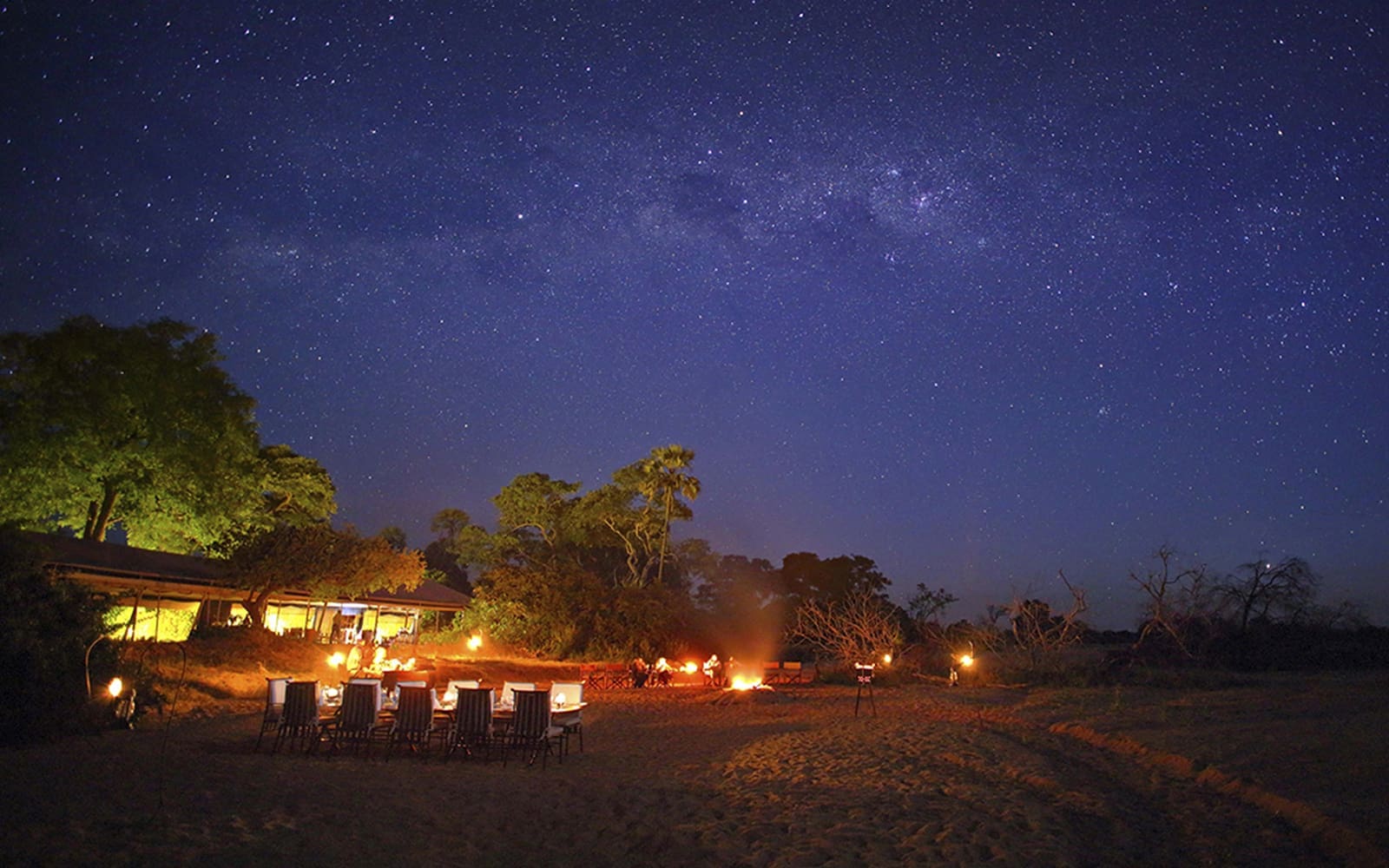
Dining on the dried Mwaguis River offers spectacular views of the night sky
Nestled under a miombo woodland canopy along the Mwagusi basin, Kwihala is another example of a Ruaha “bush experience.” The camp has 6 canvas tents, each with an en-suite bathroom and safari (bucket) shower.
Where to Stay: Jongomero Camp
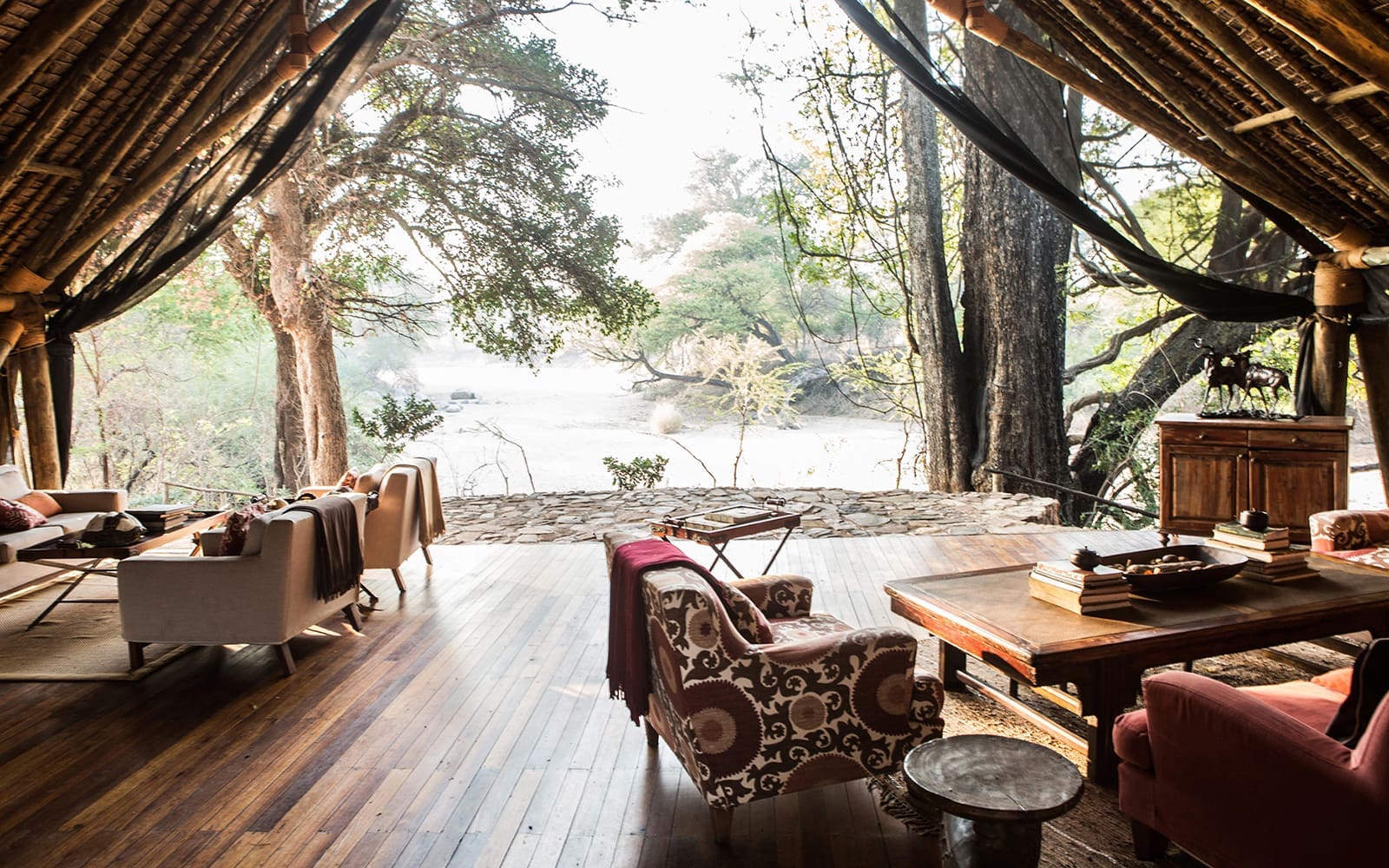
The high, thatched roof of Jongomero’s lounge
When you think of Jongomero, think “classic Africa.” The 8 luxury, en-suite tents and common areas of the camp are elevated on gorgeous wood platforms and covered by thatched bandas. Located in Ruaha’s remote southwest, it’s also ideal for going on day-long expeditions to some of the park’s wildest areas – you’re very likely to spot some sable! Jongomero also has a pool, perfect for cooling off after your morning activity.
Where to Stay: Ikuka Safari Camp
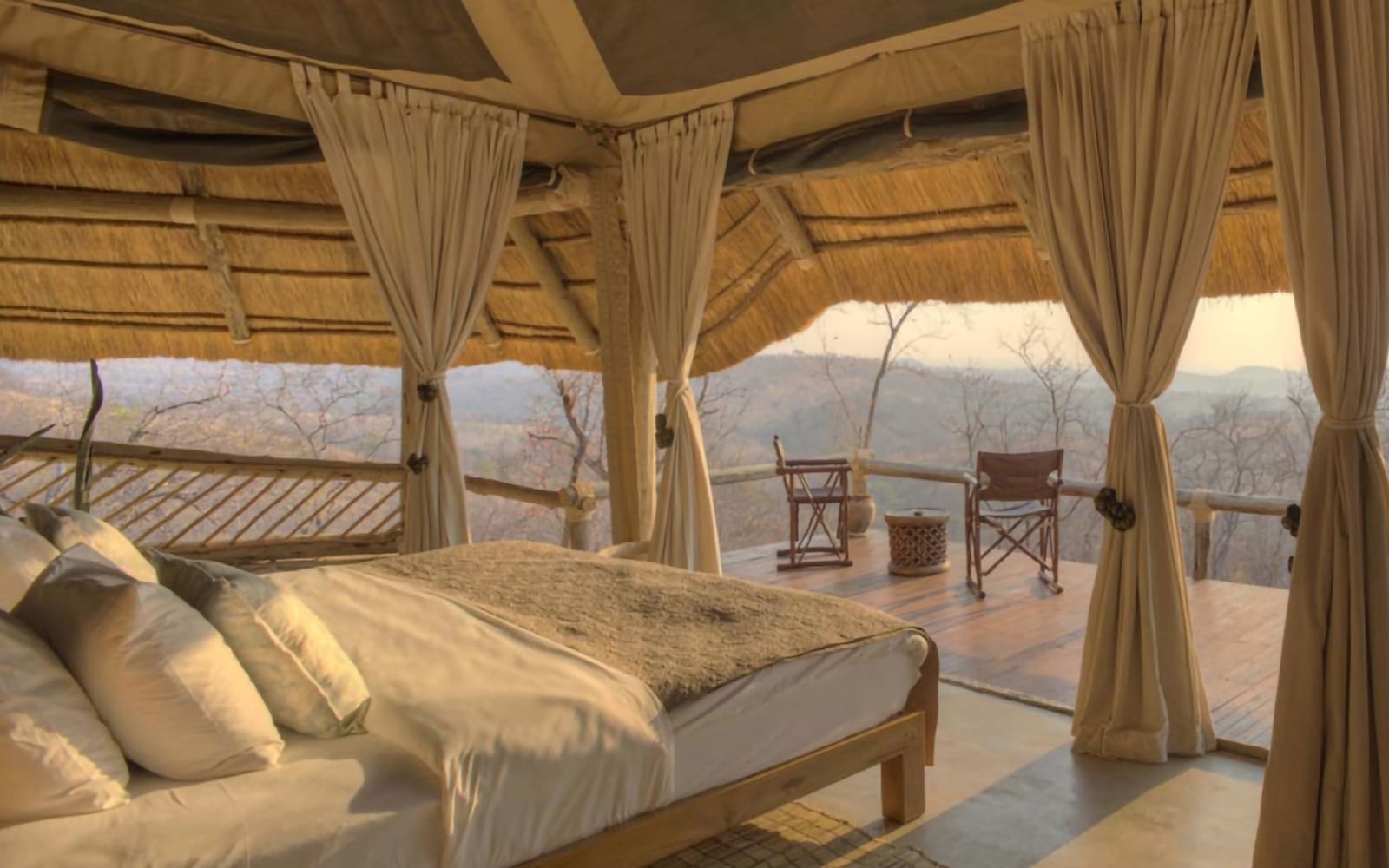
Ikuka has arguably the best views in the park
Ikuka is picturesquely situated atop the Ruaha Escarpment. The 6 banda-covered rooms (including one family room) are uniquely designed. During the day, the rooms are completely open, allowing for cool breezes and a more intimate immersion with nature. At night, the rooms are then closed off with canvas tenting. The camp also features a great pool with expansive views of the Ruaha valley below.
Nyerere National Park
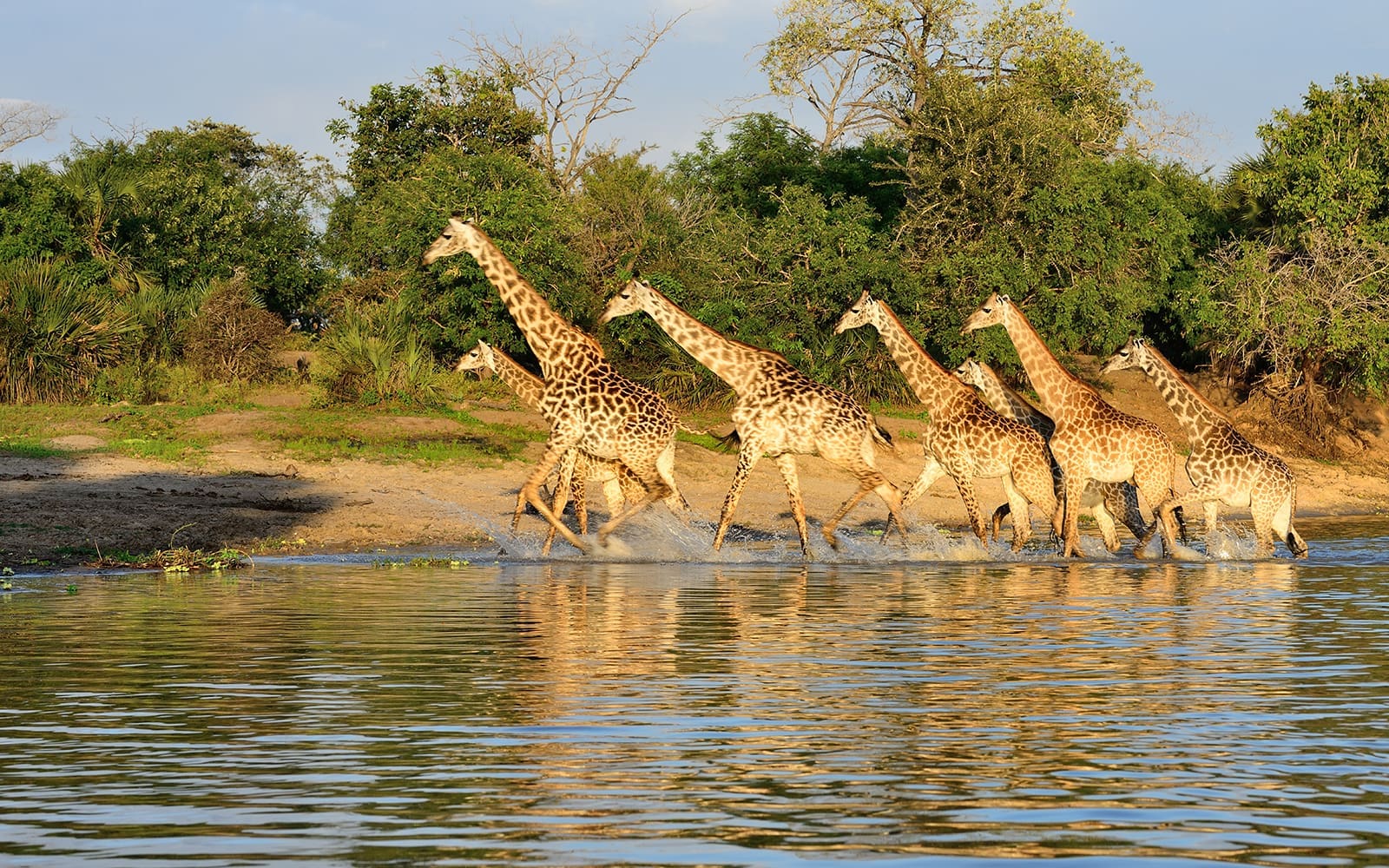
Water plays a major role in the Nyerere safari experience
As you head go downriver along the Ruaha River, you come across the edge of Africa’s Great Rift Valley. The elevation drops notably, until the river merges with the Rufiji River. North of these two rivers’ junction is Nyerere National Park’s prime game viewing area. This part of the park is predominantly composed of miombo woodlands, floodplains, river channels, grasslands and marshes, making for excellent game viewing on land – and water!
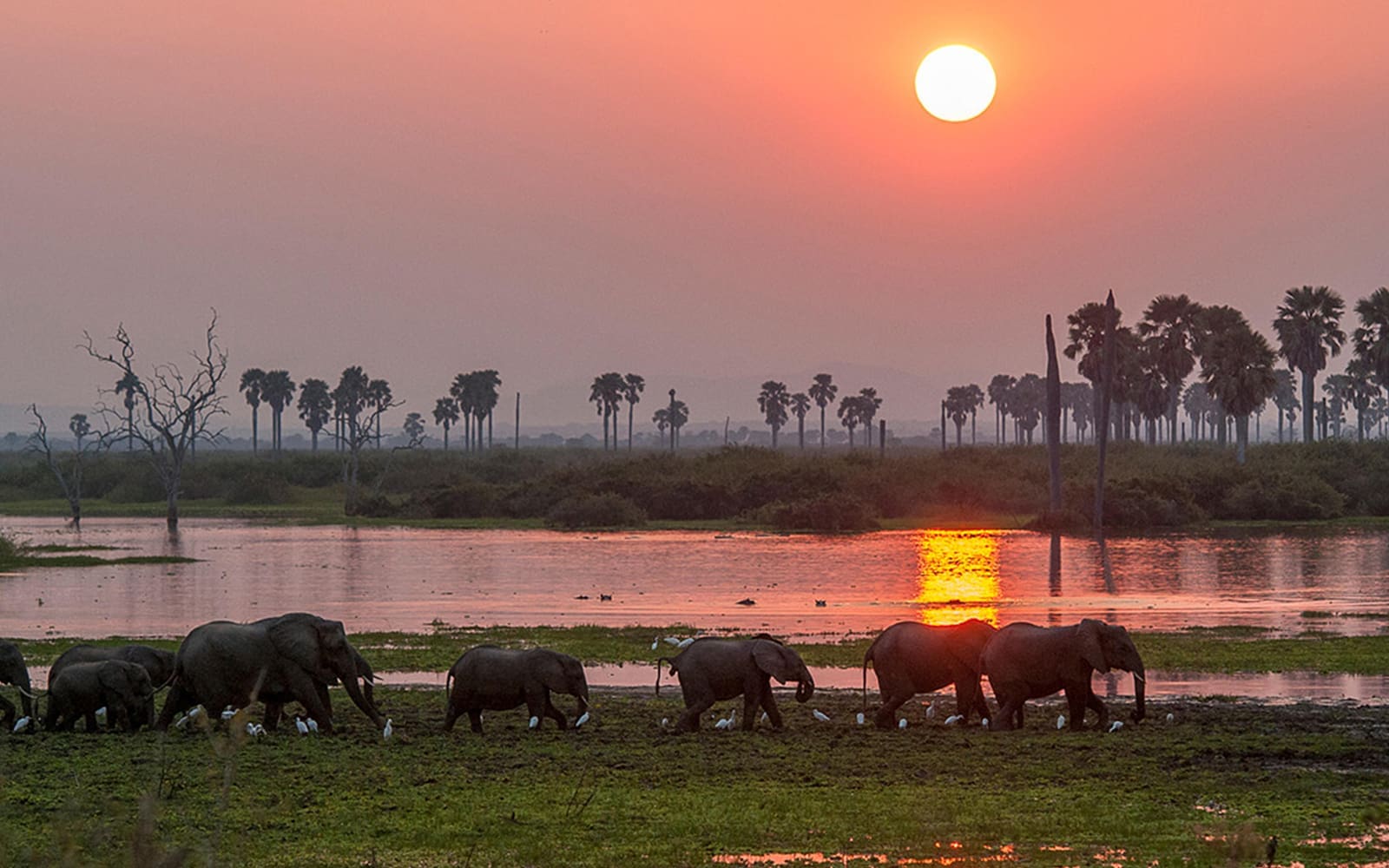
Elephants crossing the Rufiji River
Formerly known as Selous Game Reserve, this park’s most unique selling point is the opportunity to see iconic wildlife while boating, a rarity in East Africa. Buffalo, elephant, giraffe (one of Africa’s largest populations), and various antelope species are frequent sights along Selous’ lakes and river shores. And of course there are plenty of hippos and crocodiles! Predator-wise, lions are commonly seen while leopards are occasionally seen.
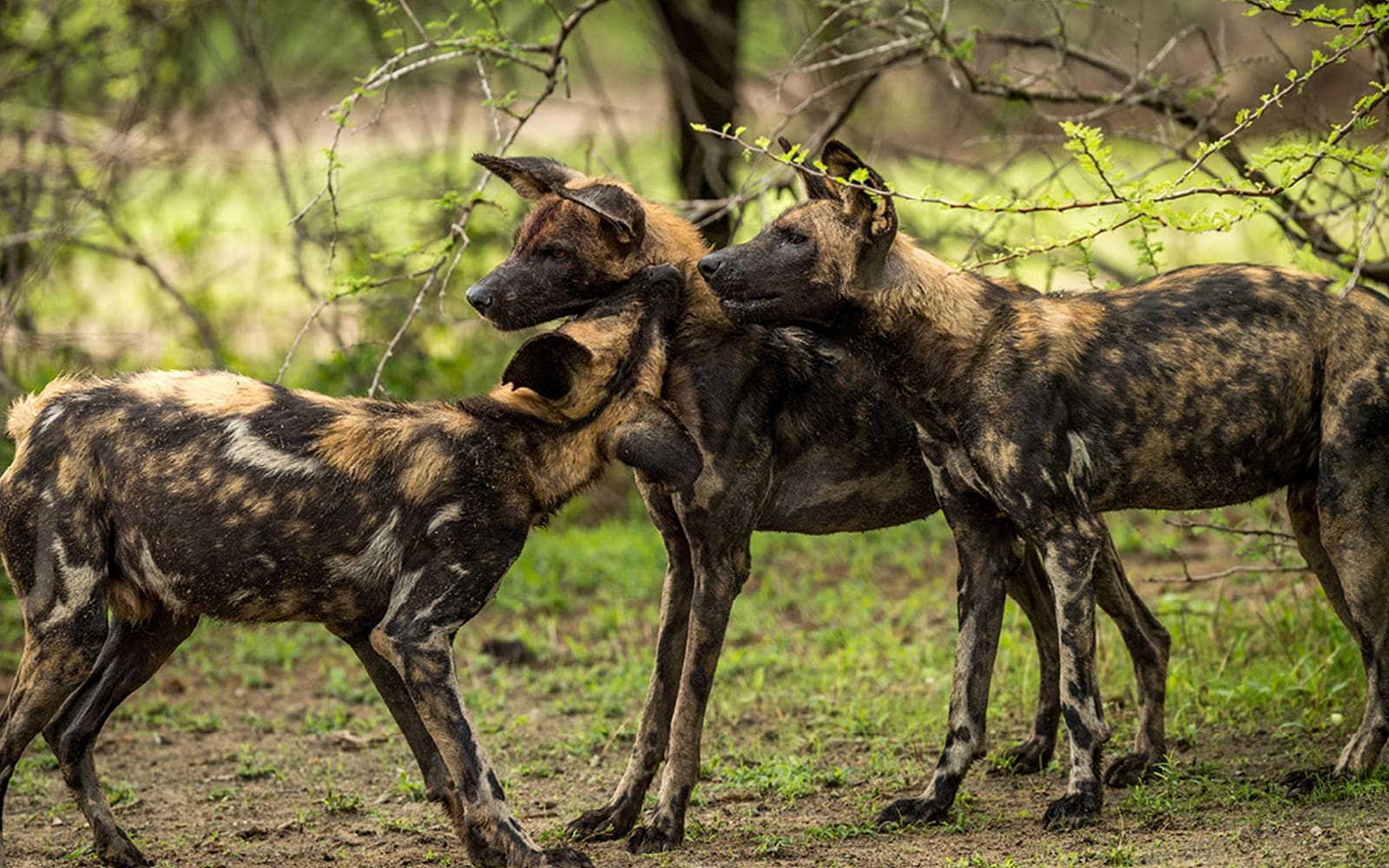
The best time to see Wild Dogs is towards the end of the Dry Season, when pups begin leave their dens
Perhaps this park’s most notable wildlife highlight its African Wild Dogs. Nyerere has East Africa’ largest population and is one of the best places in Africa to see them. For visitors keen to see Wild Dogs, AAC advises you visit from September to November.
Because they’re so mobile, Wild Dogs are notoriously difficult to track – except when the alpha female has its litter. For roughly 3 months of the year, Wild Dog pups will gradually grow and acquire their hunting abilities. But until then, packs will gravitate around a den, bringing back fresh kills for their pups to feed on.
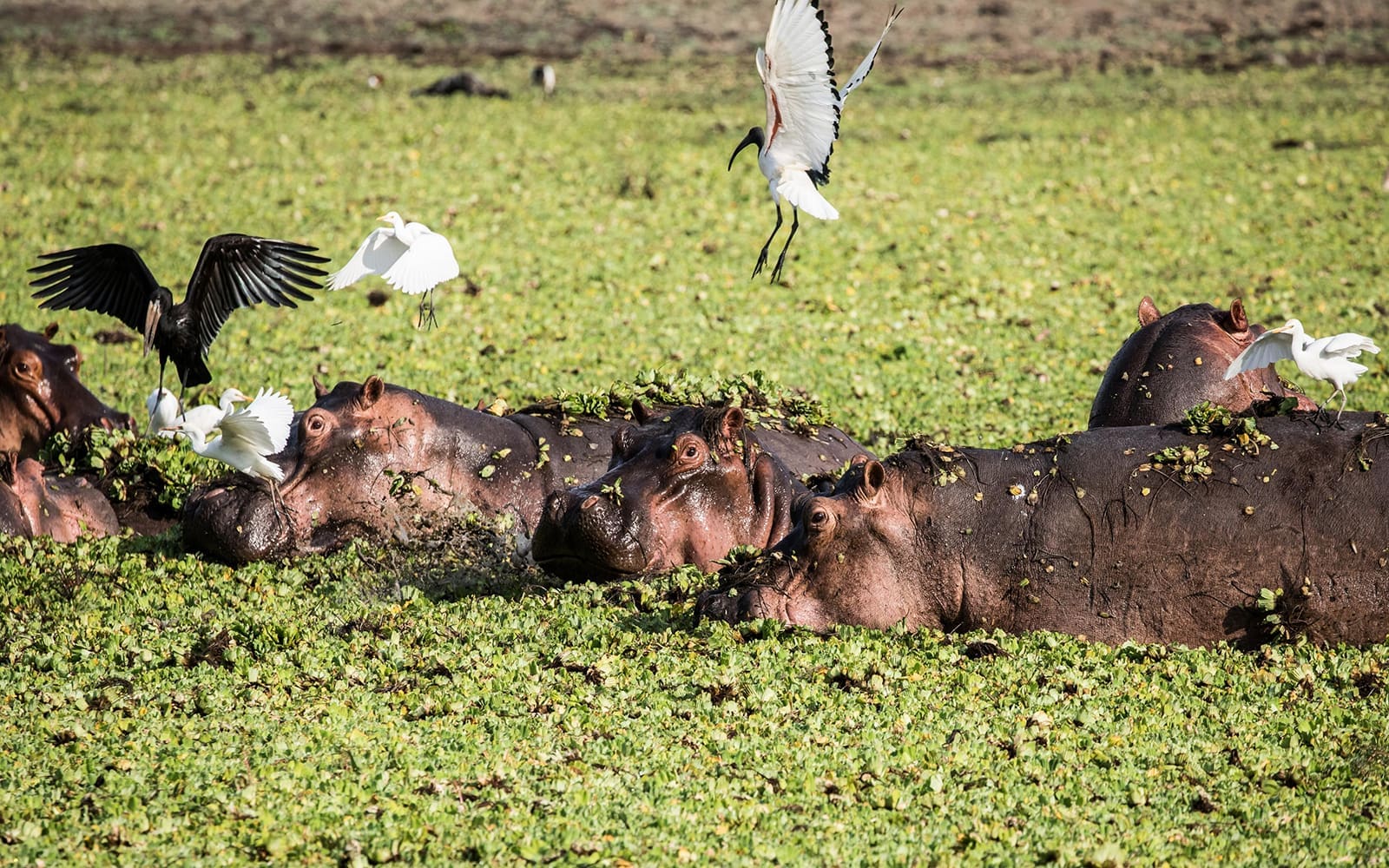
Because of the park’s many lakes, lagoons and rivers, there are many hippos here
Outside of seeing Wild Dog, the Best Time to Go to Nyerere depends on a couple of factors. If you want to be out on a boat as much as possible, AAC advises visiting early in the Dry Season (June – August) when water levels are still high. But in general, the best time to go is from July – October during the reserve’s dry season. Animals will increasingly concentrate along riverbeds, making game viewing very productive on foot, on a game drive, or on a boat. This also the best time of year to go fishing!
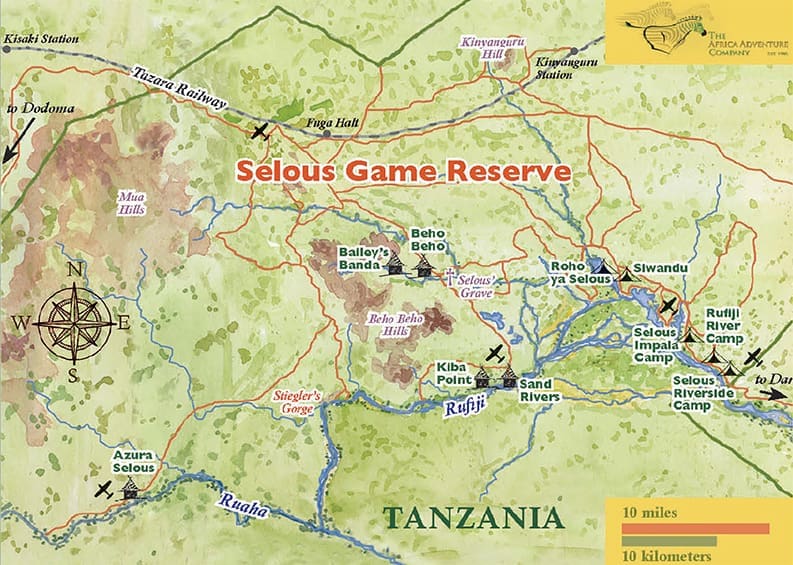
November and June are shoulder season, which offers more affordable rates. However, each month has its drawbacks. During the month of June, vegetation is at its thickest, obscuring wildlife sightings. Additionally, the Wet Season is just coming to a close, meaning wildlife is still dispersed.
During the month of November, Selous’ temperatures peak. Additionally, visitors should expect afternoon rains – and less accessible roads.
Activities in Nyerere
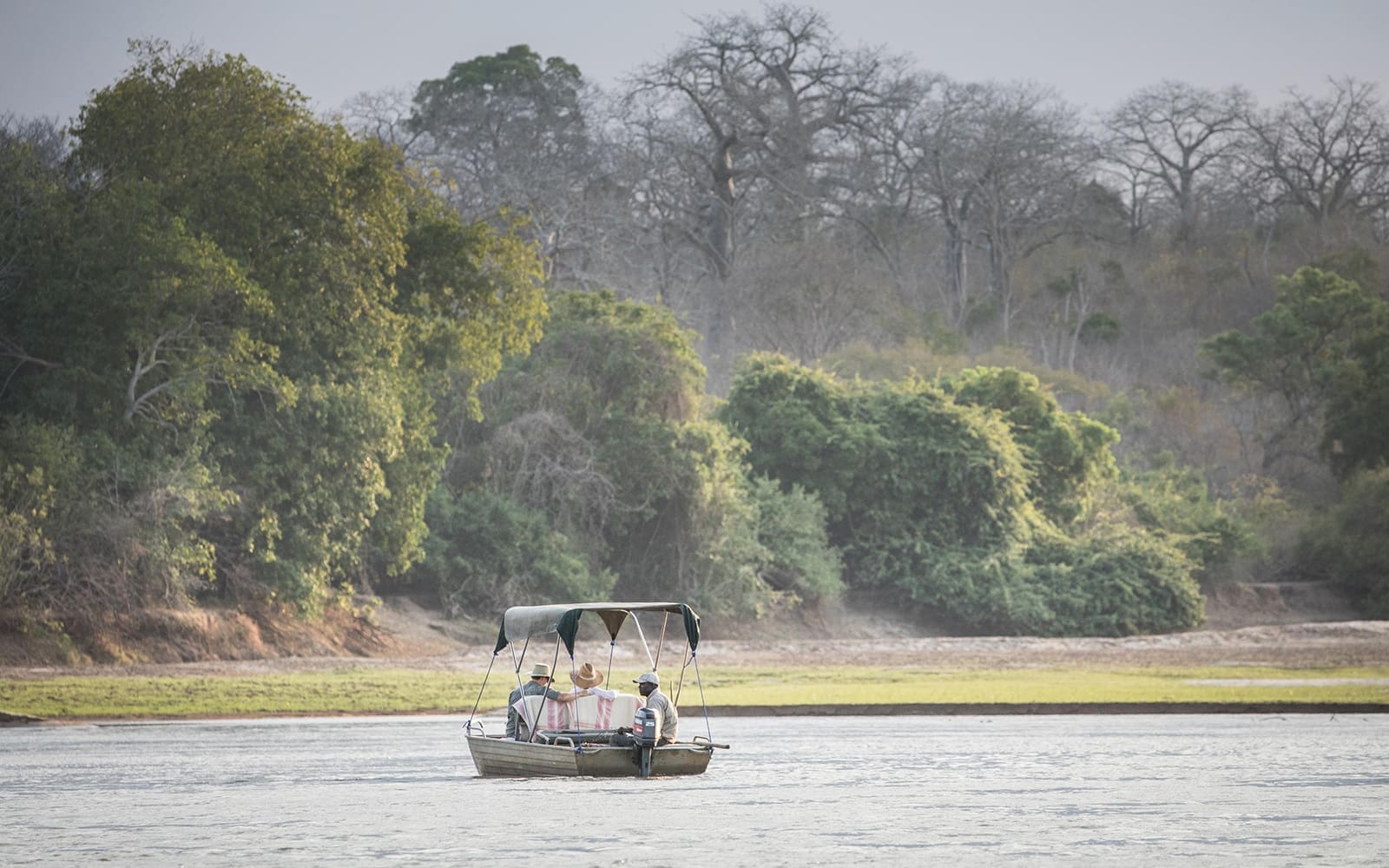
Watch out for animals coming to down to drink and the many birds
Beyond boating safaris, visitors to this park may also go fishing. The catfish and tigerfish are most likely to bite during the dry season. Boating also allows visitors to go to a picturesque sundowner or picnic location. For those conscious of the sun, some camps’ boats will have awnings overhead.
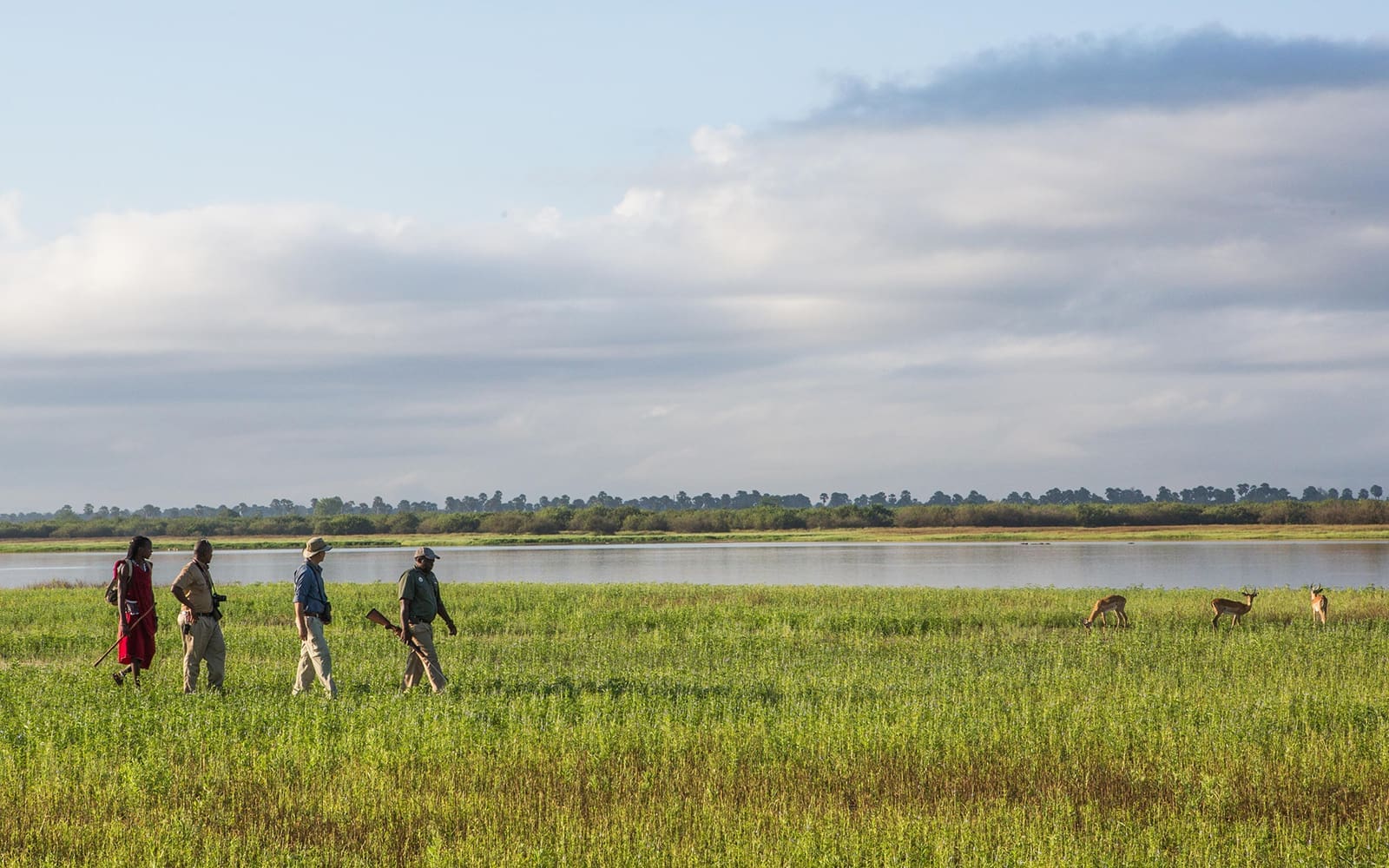
Walking safaris here are among Africa’s most adventurous
Walking in Nyerere is a treat. After all, the reserve is named after the British explorer, big game hunter and conservationist. The best time of year to walk is during the dry season when the marshes and floodplains are dry enough for easy maneuvering. Like Ruaha, walking safaris here do not require a high level of fitness: the terrain is slightly rugged, but not at all steep. Game drives only occur during the day, and the off-roading policy is stricter than at Ruaha.
Where to Stay: Siwandu
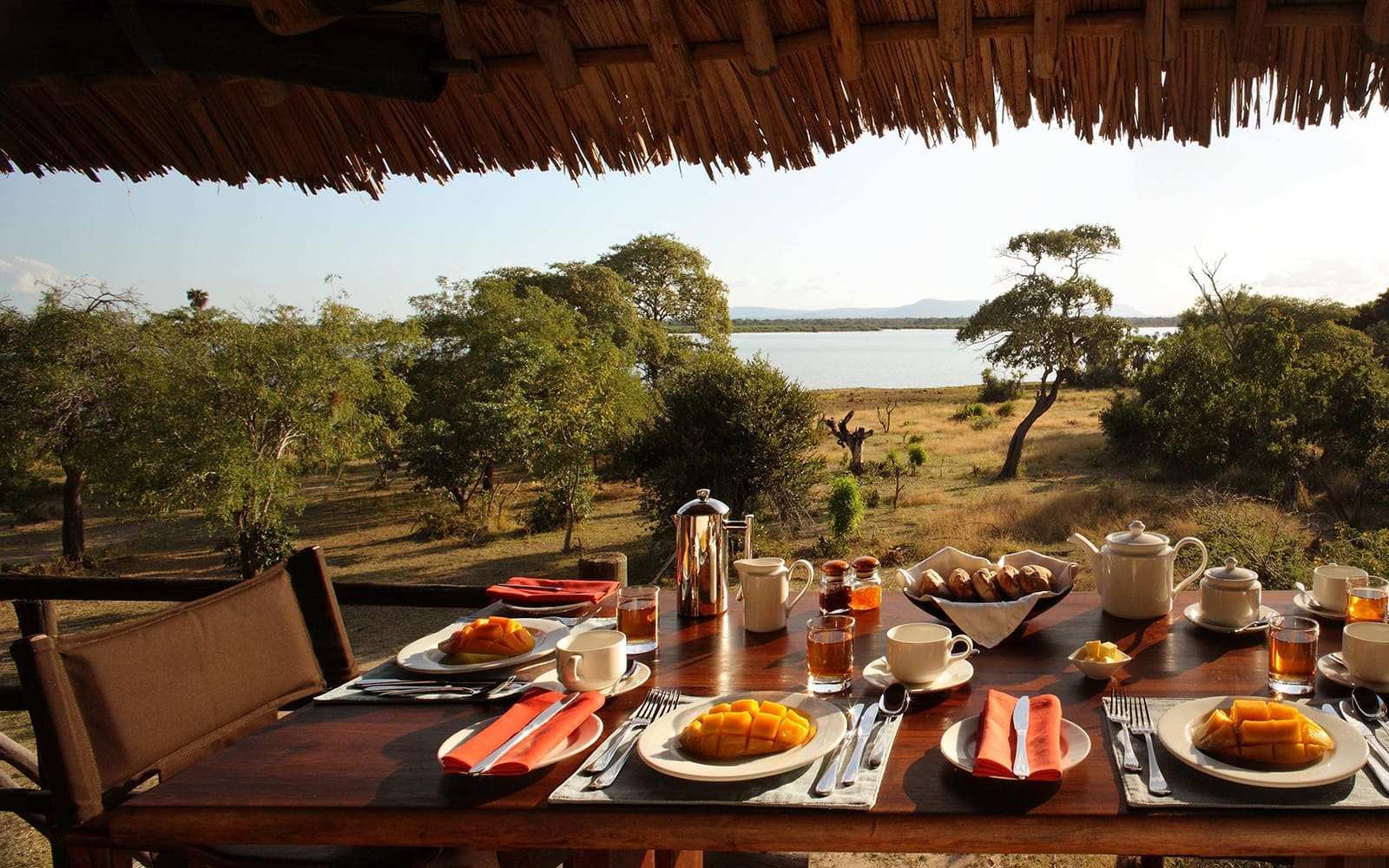
A breakfast at Siwandu
Siwandu lies on the banks of Lake Nzerekera, a back water to the Rufiji River. Each of the 12 safari tents is on its own raised timber platform, affording guests great views of the African bush. The area around camp is highly populated with game and viewing from one’s tent is often spectacular. And after a day a morning of game viewing, you can take a dip in their relaxing pool.
Where to Stay: Beho Beho
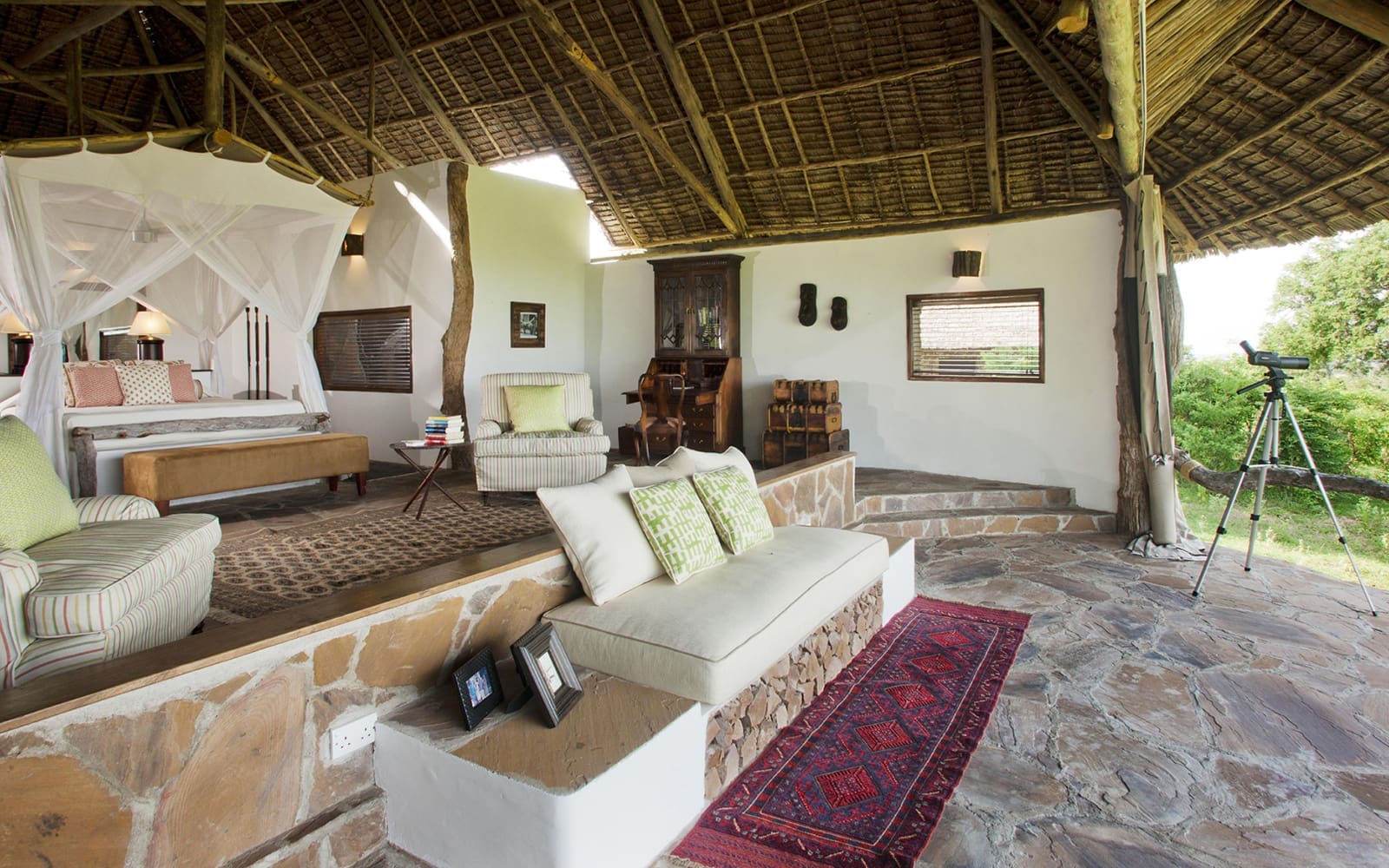
The stone cottages at Beho Beho are very spacious
Beho Beho is situated in the northern sector of the Selous Game Reserve. There are eight stone cottages, the fronts of which are totally open extending to a spacious verandah. It can be secured for the night with ‘tented curtains’ or left open. The open sided lounge and dining area together with the cocktail bar and billiards room provide a sophisticated setting for post safari relaxation and the swimming pool and deck an ideal place to cool off. The camp is a luxurious base from which to explore Nyerere on foot, by boat or by open safari vehicle. The camp’s experienced guides will plan and personalize your daily safari program.
Where to Stay: Roho ya Selous
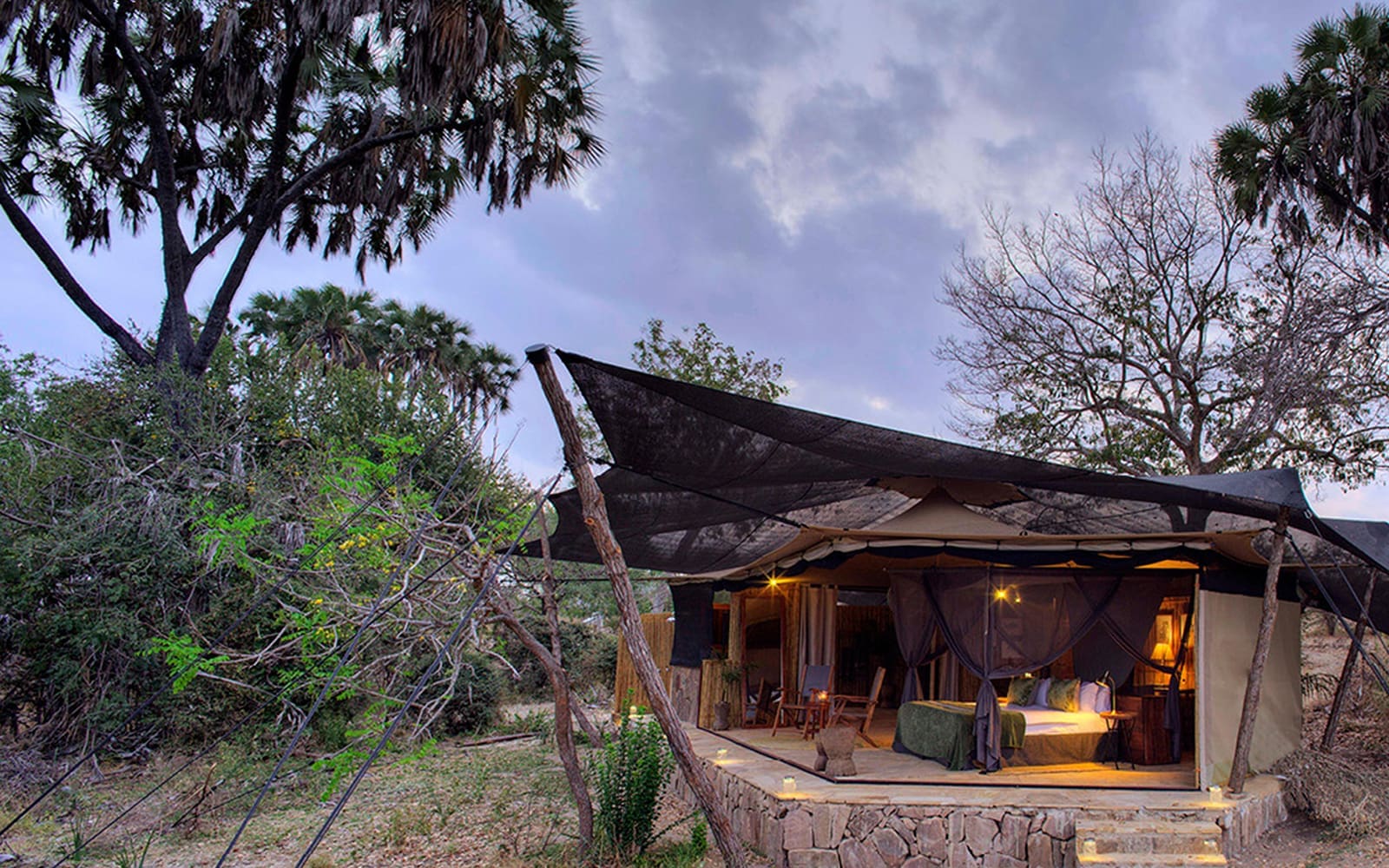
One of the unique tents at Roho ya Selous
Roho ya Selous is ideally located in the heart of the park’s best game viewing area. Close to the waterway that links Lake Manze to Lake Nzerakera, boating is a key activity. The stylish camp features 8 canvas tents, including 1 family tent, each with an over-bed cooling system for the hotter months.
Where to Stay: Sand Rivers Selous
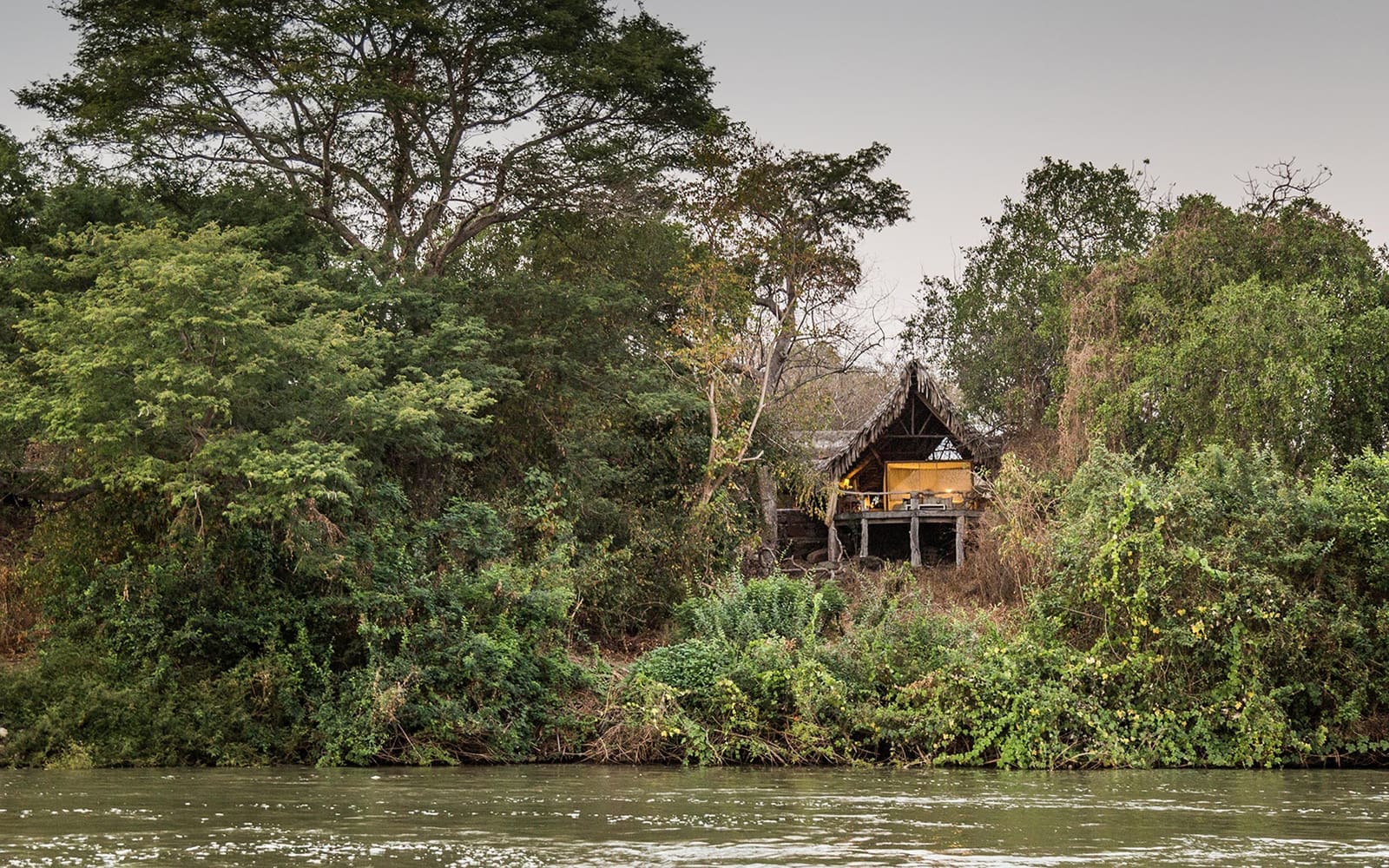
Each chalet at Sand Rivers Selous overlooks the Rufiji River
Overlooking the Rufiji River, Sand Rivers Selous is built on the river’s north bank. The eight thatched chalets are luxurious and spacious. From the lodge you will be able to get a superb all-around experience of the bush –from watching the wildlife from your veranda to walking in the bush or fly camping over night. Each evening you’ll have a chance to discuss and plan your activities for the following day with your guide.
Katavi National Park
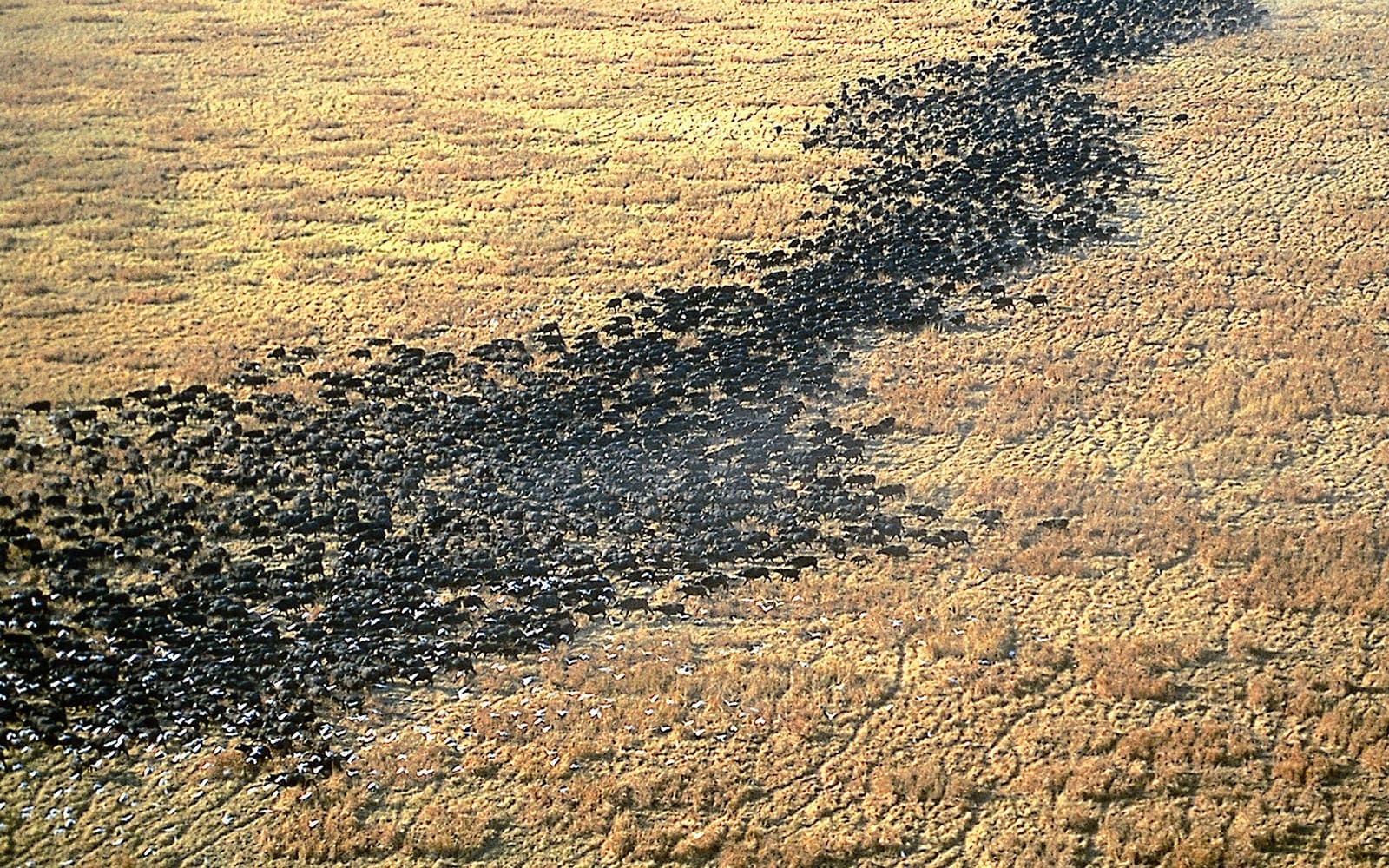
A trademark of Katavi are its immense buffalo herds
There are few places in Africa as wild as Katavi National Park. Due to its remoteness, very few safariers visit. But for those who appreciate exclusivity above all else, this park deserves your consideration. The park’s landscape is characterized by Lake Katavi and floodplains in the north and Lake Chada in the southeast. The Katuma River connects the two. During the dry season months, water recedes, and is only available in these lakes and rivers. This is when Katavi’s golden plains are full of wildlife.
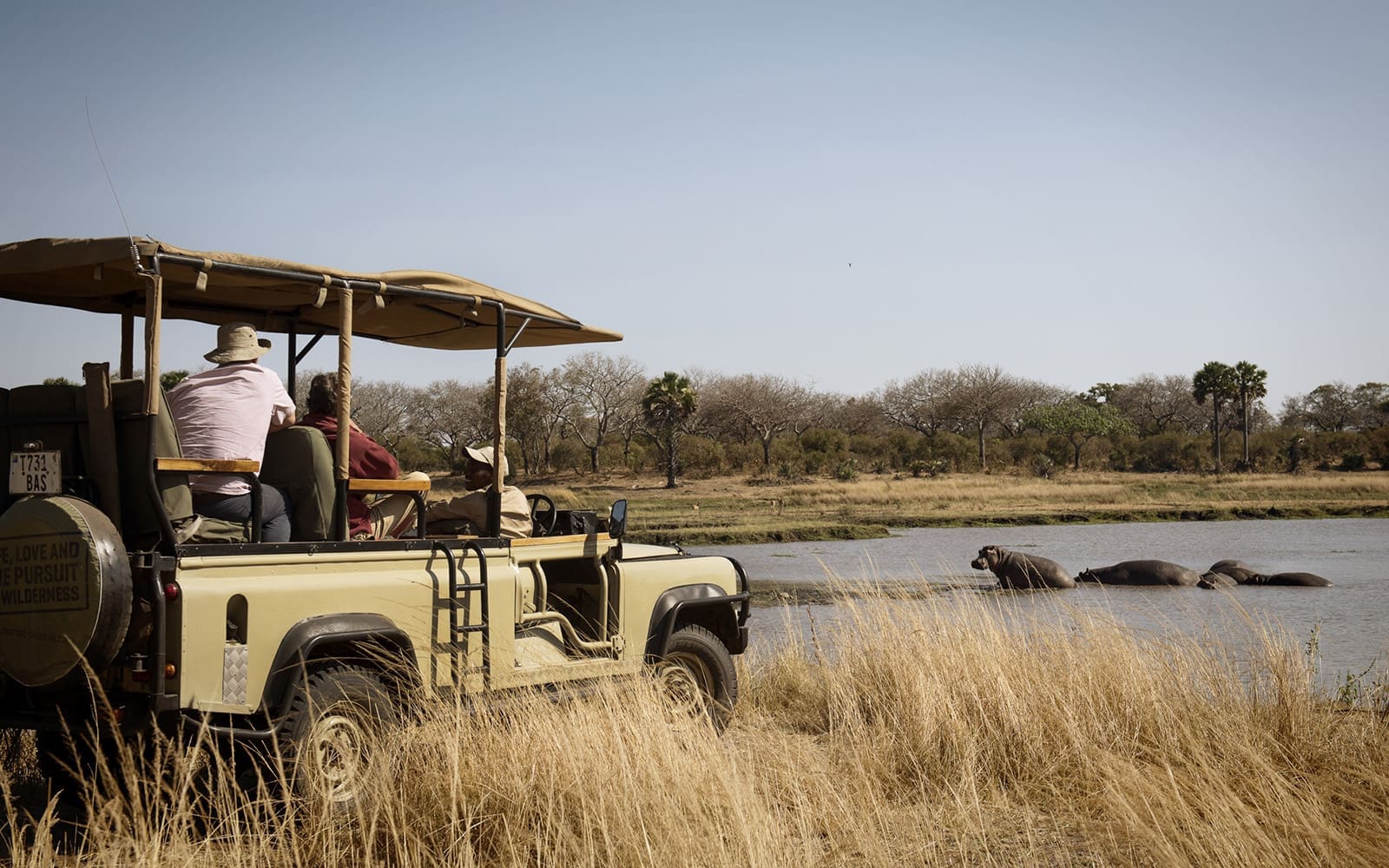
Katavi has a large concentration of hippos and crocodiles
Wildlife includes hippo, crocodiles, elephant, zebra, lion, leopard, eland puku, roan and sable. Herds of several thousand buffalo are sometimes seen. The best time to visit here is July to October, after the long rains have subsided/ Game drives, guided walks and fly-camping are available activities.
Where to Stay: Chada Katavi
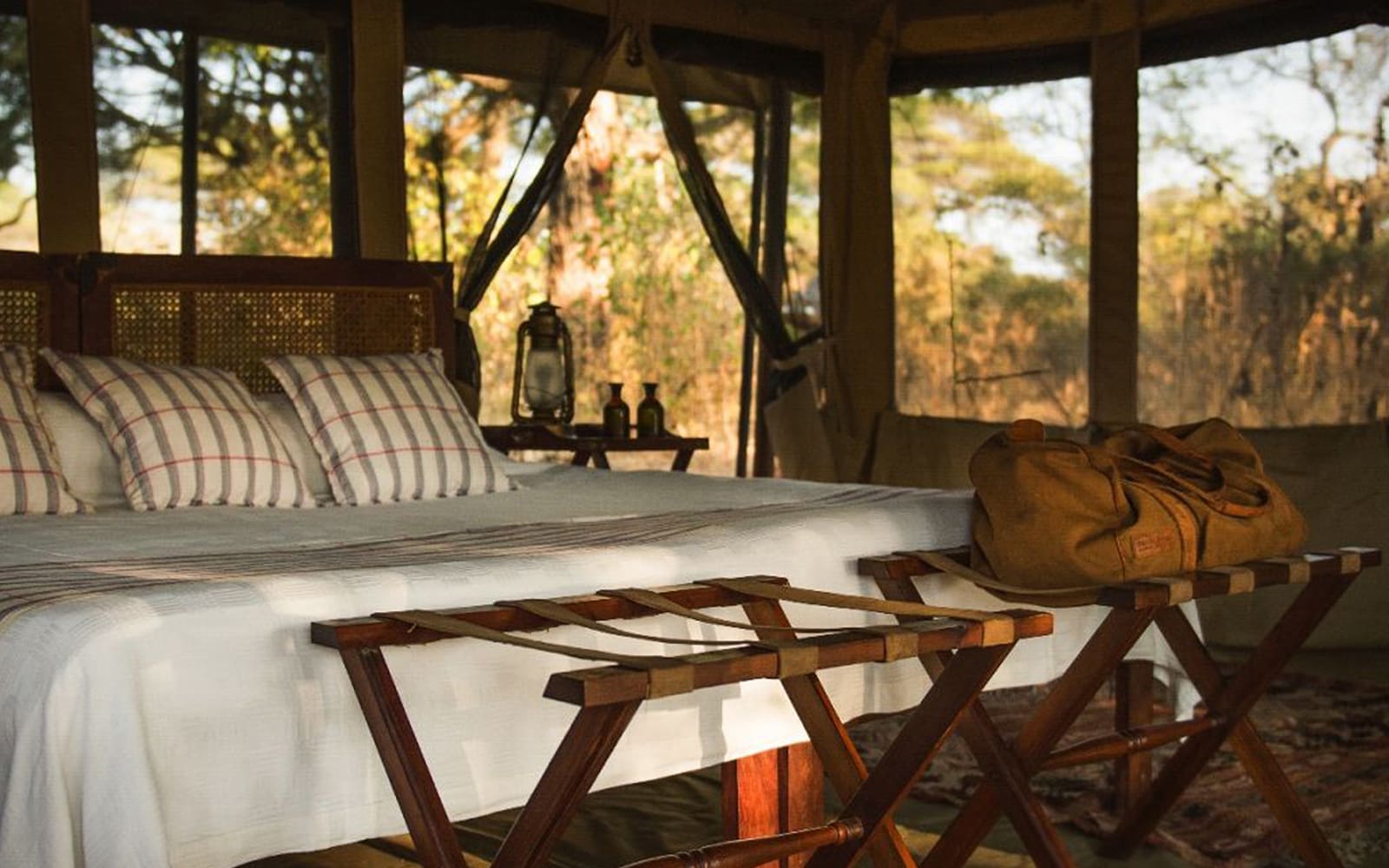
Chada Katavi is deliberately simple: from the food to the furniture: good, tasteful, and unpretentious. For people who like rustic safari experience and are focused on game viewing, this intimate bush camp is right for you.
Featured Itineraries for Southern Tanzania
8 Day | Tanzania Southern Circuit Extension
17-Day | Southern Tanzania Adventure Safari
18 Day | East Africa Wildlife Extravaganza

